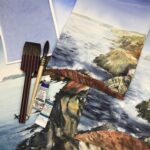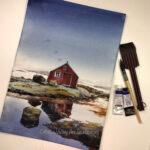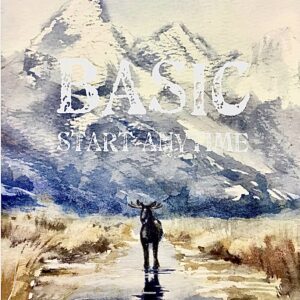Explore the landscapes of Newfoundland and Labrador, Alberta and Ontario in these mini courses.
Extend your watercolour skills while painting the fauna, coasts and seascapes of Newfoundland, the mountains, lakes and parks of Alberta and the Winter fairyland of Ontario.
Newfoundland and Labrador.
Click to read more about this course.
Newfoundland and Labrador is one of mini-course of the Canadian landscape set of courses. This mini course takes you to the East coast of Canada where you will learn to paint puffins and ocean coast landscapes.
This course contains four lessons. You will learn the theory of atmospheric perspective and use this knowledge in practice. You will paint four landscape scenes with different viewpoints. You will learn how important it is to understand where the line of horizon is and how it changes the impression of your painting.




Read more about the Alberta mini course.
Read more about the Ontario ZOOM course. Video course is coming soon.
Materials that I am going to use during the course;
This list is only for your information, there is no need to get exactly what I am using:
Watercolour paper, per lesson:
- One or two sheets of The BEE Paper company, 100% cotton or Paul Rubens watercolour paper, 50% cotton, cold press, 300 gm2, for the class practice;
- And /or One or two sheets of Arches watercolour paper, cotton, cold press or rough, 300 gm2, for the class practice;
Watercolour brushes;
– Round # 10-12, # 6 and # 2; Escoda, Paul Rubens or Dainayw;
– Flat synthetic brush 3/4 and 1 1/2 or larger (Escoda, Grumbacher, Santa Fe Art Supply, Connoisseur )
– Liner brush (Princeton, Artist’s Loft)
Watercolour paint;
Ultramarine
Indigo
Cobalt Blue
Cerulean Blue
Lavender (optional)
Neutral Tint
Payne’s Grey
Olive Green
Dark Green (optional)
Burnt Umber
Burnt Sienna or Quinacridone Rust
Indian Red
Orange
Ochre
Buff Titanium
Yellow
Opera
Red
Violet

White Gouache (optional)
And/or
White pen, Gelly Roll, 08, Sakura, Japan
And/or
Artistic tape;
Watercolour board (the board which you will tape your watercolour paper to) and plexiglass board (any plastic board that the wet paper will stick to); You can use any smooth surface board big enough to place your paper on it; glass, mirror, flat baking sheet.
Watercolour palette with a large surface for mixing pigments. Alternatively, you can use a white ceramic plate. Also, you will need a wheel palette for the lesson 2. Alternatively, you can use a ramekin.
A Pencil 3H and 2B and Eraser;
Two large jars for water;
Paper towels;
Sea sponge (optional);
Sponge (a small piece approximately 2×2 cm for the Lesson 2).
Hair dryer.
You will need an account to access courses on the site. The account may be created HERE or during checkout. Once checkout has been completed and your payment processed, an email containing your login information will be sent to your specified email account.
Please use your login information to access all purchased courses and workshops in “My Account”.












Reviews
There are no reviews yet.